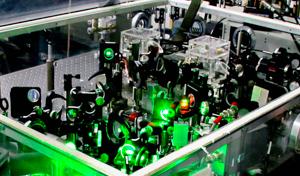Frontiers of optical science: new axis for laser optics

Image 1 Ultrashort pulses of light produced by Raman scattering from hydrogen for next generation laser optical communications
Source: International Public Relations, University of Electro-Communications, Tokyo
Frontiers of optical science: Ultrashort pulses of light produced by Raman scattering from hydrogen for next generation laser optical communications
Masayuki Katsuragawa describes his research on the manipulation of light-matter interaction for producing ultra-short pulses of laser light. “Our recent experiments on adiabatic stimulated Raman scattering in parahydrogen show potential for the realization of laser light sources producing pulses at terahertz repetition-rate frequencies. These ultra-short pulses offer a new 'axis' in the evolution of laser based optical science.”
Control systems: Fuzzy features
The natural world is not always logical, and precise states such as 'true' or 'false' are quite rare. The field of fuzzy logic takes account of this fact by creating models in which truth is represented on a continuous scale between 0 and 1. Mathematical control systems based on fuzzy logic have proved useful for real-world situations such as handwriting recognition on pocket computers, auto-focusing on cameras, and earthquake prediction. Kazuo Tanaka and colleagues at the University of Electro-Communications in Tokyo, with co-workers at Kyushu Institute of Technology and Boston University, USA, have used a sum-of-squares approach to design effective observers within three classes of T-S fuzzy systems.
Optical signal processing: Neater networks
The demand for fast access to data through optical networks requires technology that can handle ever more complex and high-bandwidth signals. However, the signal processing usually requires conversions from optical to electronic and back again, which can be power-hungry and expensive.
Now, Hung Nguyen Tan, Motoharu Matsuura and Naoto Kishi at the University of Electro-Communications in Tokyo have built an optical switching device that not only performs WDM, but also processes signals with different data formats, and convert signals between formats.
Pharmacophores: The future of drug discovery
Developing new drugs that bind exclusively to target cells in diseases such as cancer is crucial. Masumi Taki and co-workers at the University of Electro-Communications in Tokyo, together with scientists at Kagoshima University, Japan, have expanded on current drug discovery methods to create a hybrid-drug generating system for this purpose. Their system uses 'artificial-molecule evolution'- taking non-natural core molecules and adapting and optimizing them to make new 'pharmacophores'. A pharmacophore is a molecular model which can be manipulated to bind molecules for targets such as cancer cells.
Hybrid solar cells: The Mechanism of dyeing for greater efficiency
Light-harvesting organic materials have the potential to provide low cost electricity through solar power. However, current designs for organic-inorganic hybrid solar cells (OIHSCs) suffer weaknesses at the interface between organic and inorganic components and this limits efficiency. Now, Qing Shen at the University of Electro-Communications, Tokyo, and Shuzi Hayase at Kyushu Institute of Technology together with scientists in Hayase JST CREST Research Team across Japan, have succeeded in clarifying the mechanism for improving the performance of an OIHSC by adding a dye sensitizer directly onto the organic-inorganic interface.
Further information:
International Public Relations
The University of Electro-Communications
1-5-1 Chofugaoka, Chofu, Tokyo 182-8585
E-mail: ru-info-ml@uec.ac.jp
Website: http://www.uec.ac.jp/
About The University of Electro-Communications
The University of Electro-Communications (UEC) in Tokyo is a small, luminous university at the forefront of applied sciences, engineering, and technology research. Its roots go back to the Technical Institute for Wireless Commutations, which was established in 1918 by the Wireless Association to train so-called wireless engineers in maritime communications in response to the Titanic disaster in 1912. In 1949, the UEC was established as a national university by the Japanese Ministry of Education, and moved in 1957 from Meguro to its current Chofu campus Tokyo. With approximately 4,000 students and 350 faculty, UEC is regarded as a small university, but with particular expertise in wireless communications, laser science, robotics, informatics, and material science, to name just a few areas of research. The UEC was selected for the Ministry of Education, Culture, Sports, Science and Technology (MEXT) Program for Promoting the Enhancement of Research Universities as a result of its strengths in three main areas: optics and photonics research, where we are number one for the number of joint publications with foreign researchers; wireless communications, which reflects our roots; and materials-based research, particularly on fuel cells.
Website: http://www.uec.ac.jp/
Associated links
- University of Electro-Communications e-Bulletin
- Frontiers of optical science
- Control systems: Fuzzy features
- Optical signal processing: Neater networks
- Pharmacophores: The future of drug discovery
- Hybrid solar cells: The Mechanism of dyeing for greater efficiency
- The University of Electro-Communications
Media Contact
All latest news from the category: Power and Electrical Engineering
This topic covers issues related to energy generation, conversion, transportation and consumption and how the industry is addressing the challenge of energy efficiency in general.
innovations-report provides in-depth and informative reports and articles on subjects ranging from wind energy, fuel cell technology, solar energy, geothermal energy, petroleum, gas, nuclear engineering, alternative energy and energy efficiency to fusion, hydrogen and superconductor technologies.
Newest articles

Silicon Carbide Innovation Alliance to drive industrial-scale semiconductor work
Known for its ability to withstand extreme environments and high voltages, silicon carbide (SiC) is a semiconducting material made up of silicon and carbon atoms arranged into crystals that is…

New SPECT/CT technique shows impressive biomarker identification
…offers increased access for prostate cancer patients. A novel SPECT/CT acquisition method can accurately detect radiopharmaceutical biodistribution in a convenient manner for prostate cancer patients, opening the door for more…

How 3D printers can give robots a soft touch
Soft skin coverings and touch sensors have emerged as a promising feature for robots that are both safer and more intuitive for human interaction, but they are expensive and difficult…





















